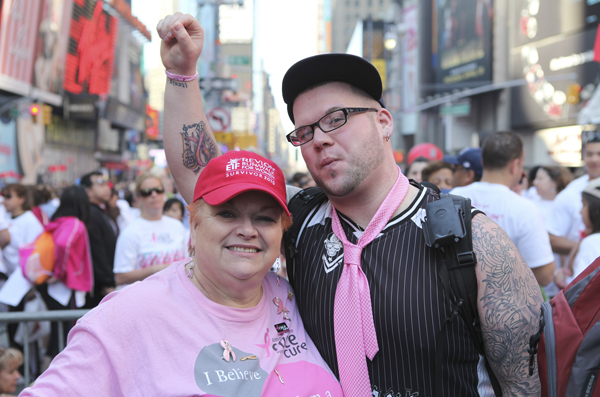
Participants at the 2010 Revlon Run/Walk for Women, New York City (Léa Pool)
Pink Ribbons, Inc. is a timely warning about the political message behind the philanthropic-corporate complex that for decades has tied up fundraising, research, discussion, and perceptions about breast cancer in a big pink bow. But even this documentary and Samantha King’s 2006 book that it’s based on didn’t predict how controversial Susan G. Komen for the Cure would become.
Director Léa Pool scrupulously includes interviews with her targets, including Nancy G. Brinker, founder and CEO of Komen, as well as the marketing and branding executives who first capitalized on the idea of the omnipresent pink product merchandizing and promotions, like lighting up monuments around the world in a pink glow. Their efforts attract the money and attention of thousands across North America to large-scale events. Diverse enthusiastic and emotional participants of such events as the Revlon Run/Walk for Women and Komen’s Race for the Cure are followed as they describe how breast cancer has affected them and their families. Their earnestness makes the accusations of cynicism by activists, researchers, and writers, including Barbara Ehrenreich, that much more poignant.
The overwhelming impression from these pink events is their relentless upbeat mood, where the word “cancer” is never mentioned and “survivors” are celebrated in what King calls “the tyranny of cheerfulness.” That approach meets tough reality through the insights of the IV League, a Texas support group of women facing the awful difficulties of final stage 4 breast cancer. They resent being treated as failures because they didn’t beat it with anything that was in their control and that they won’t survive it.
The pink establishment stresses a cure that follows early detection and treatment. Dr. Susan Love, a prominent longtime protester, lambastes that the “slash, burn, and poison” modalities still prevail, and the film scrutinizes how these approaches benefit the corporations that produce the drugs and equipment and serve on the pink organizations’ boards. That prevention and cause are ignored is hammered again and again, especially when evidence points to chemicals in the environment, workplaces, or, pointedly, in the products the corporate partners sell, including cosmetics. (Not discussed are genetic factors, even with all the controversies around genetic testing and prophylactic surgery.) So it was ironic that Komen’s priority for mammograms got the organization into hot water earlier this year when it became known they would no longer give Planned Parenthood grants to provide screening for low-income women, and then had to backtrack due to public pressure.
The storm also brought attention to Komen’s close connections to Republican policies, though this documentary over-emphasizes that genesis, from the specifics of Brinker’s position in the Bush administration (ambassador to Hungary) to general blame for the privatization of health philanthropy. Some of that criticism seems to reflect the Canadian filmmakers’ preference for government funding, but that was also the goal of the first woman to make handmade peach-colored ribbons as a lobbying device, Charlotte Haley. She refused to let Lauder’s foundation use the image for its vague priorities of “connect, communicate, and conquer.” They switched to pink, though there’s no mention here that a color seen as ultra-feminine makes it that much more difficult for men with breast cancer to be recognized.
Among the array of face-the-camera interviews that effectively capture personalities and positions, the righteous anger of Barbara Brenner, of Breast Cancer Action, is a poignant tribute to her legacy of activism as she since developed ALS and can no longer speak. But her and others’ sneering at how little money is raised at all the beribboned events and from what they call “pink washed” products are familiar accusations at sponsored philanthropy going back to the Live Aid concerts in 1985. (The montage of ads, items, and partners is staggering, particularly the unhealthy, such as KFC, and the incongruous ones, like Ford Mustang and NFL players.)
As a development professional for over two decades, I see a woeful gap in not interviewing fundraisers about the context of administrative mechanics, the huge overhead costs of charity events, and how money is raised from participants, and not just through fees but subsequent solicitations. Even the organizations critical of the pink hegemony are non-profits that have to use similar fundraising techniques. Pink Ribbons, Inc. makes a convincing case that the best use of your charitable dollar is to contribute directly to an organization and not through an event or product purchase, certainly not a pink one.






Leave A Comment